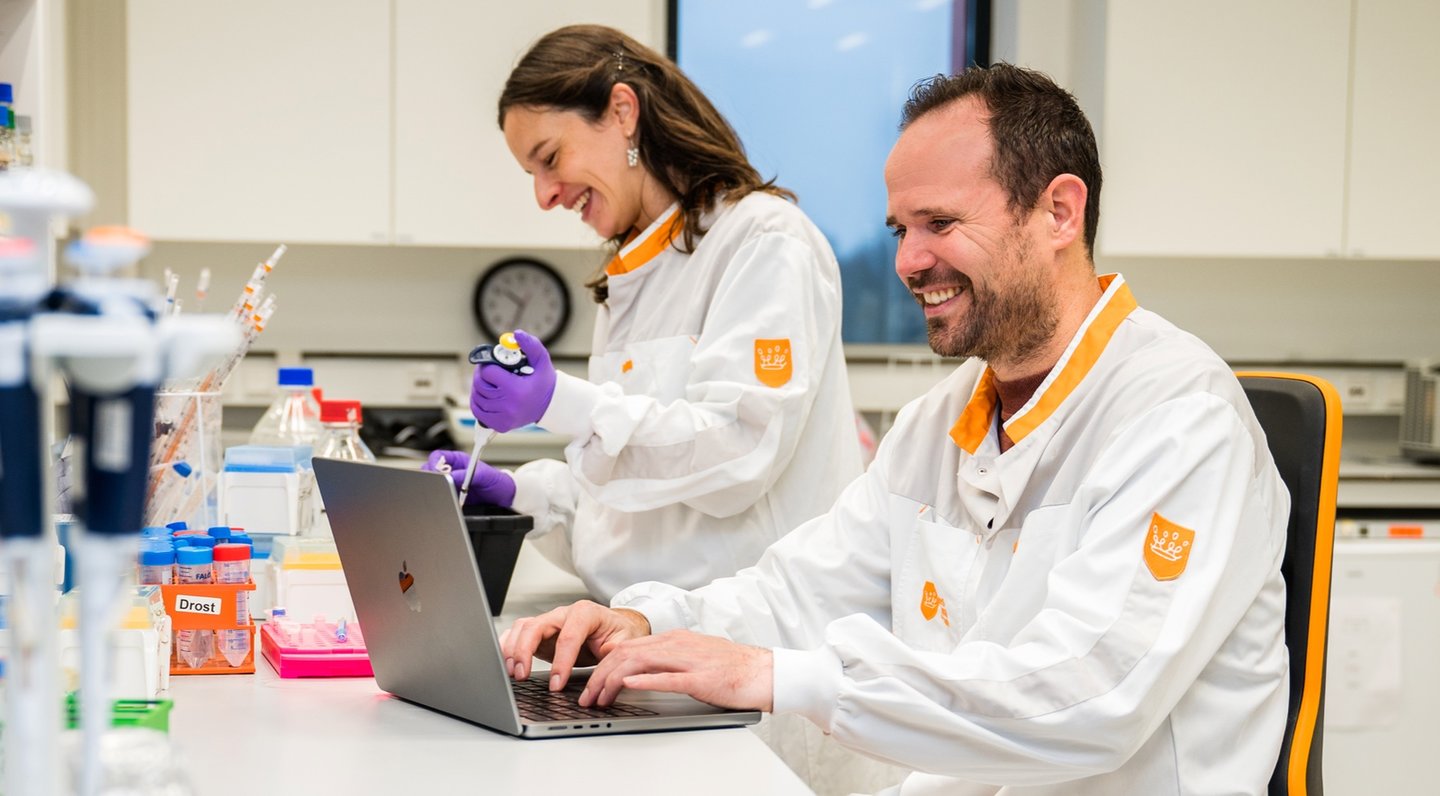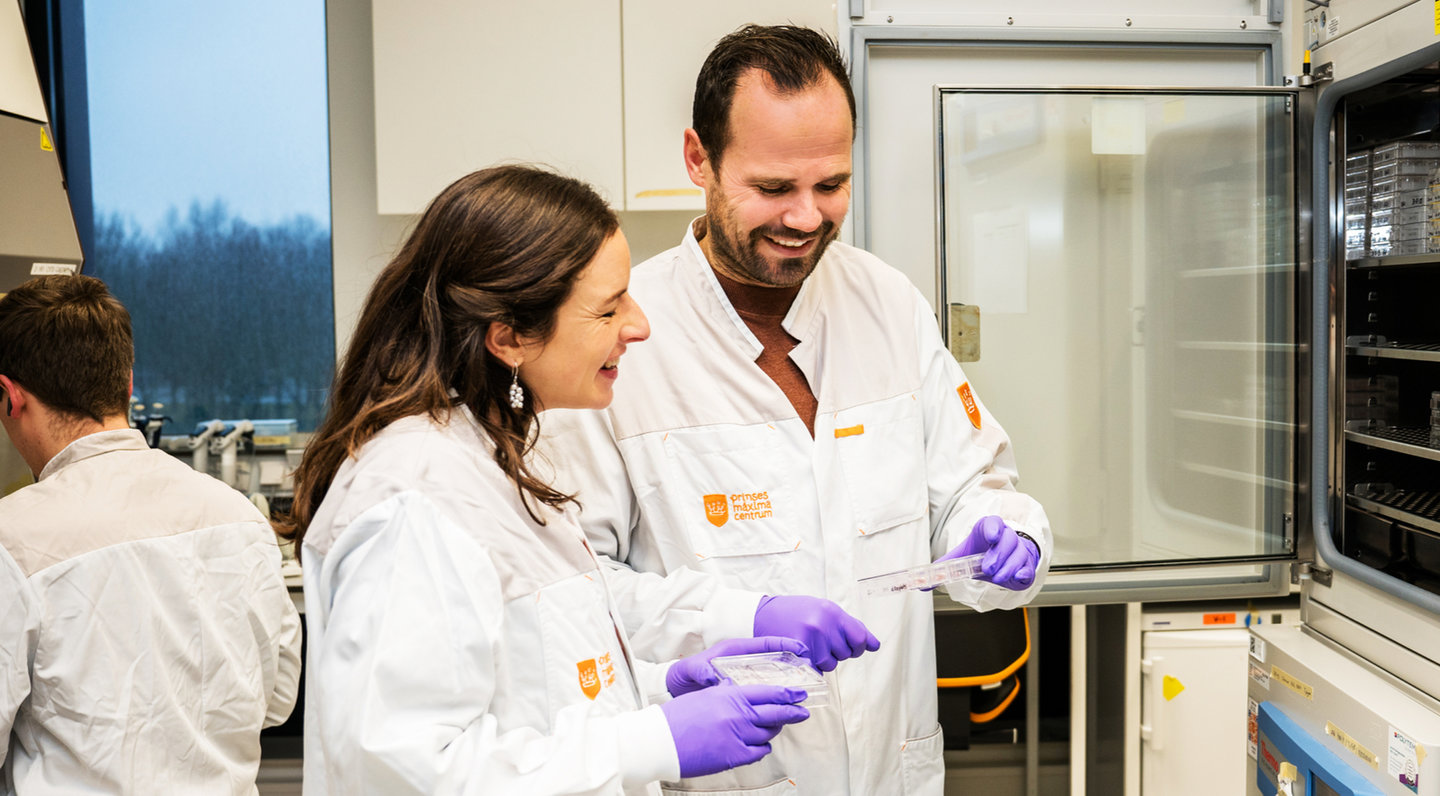Duo Interview
06
The promise of disease models for cancer therapy development
In this interview, Marjon Pasmooij and Jarno Drost share their insights on the impact of organoid technology in cancer research.
In the world of medical research, good disease models are key to paving the way for new treatments and therapies. Marjon's background is in cell biology with a focus on rare diseases. She currently works as head of the science department at the Dutch Medicines Evaluation Board (MEB) and co-leads the Regulatory Innovation workstream of Oncode Accelerator. Jarno, group leader at the Princess Máxima Center for pediatric oncology, is Oncode Investigator since 2019. His research makes use of organoids, with a particular interest in pediatric malignancies. Since the start of Oncode Accelerator, he has co-led the Organoids platform together with Laurens van der Flier.
Jarno: “My primary focus is on pediatric cancer. It’s a field where organoid technology has a major impact. Prior to the development of organoid models, I experienced significant challenges in conducting research on child tumors. They are relatively rare, and the material available for research was limited and fragmented across the Netherlands. Additionally, traditional cell lines often do not represent the tumors adequately. Organoids have proven to be a real game-changer. Initially developed for healthy tissues and adult tumors, pioneered by Hans Clevers, it required some optimization when dealing with childhood tumors since these often originate from different germ layers than adult malignancies. We have now successfully established organoid models for different types of childhood tumors. We hope that the use of these models will allow for more efficient translation of lab findings to the clinic compared to classical cancer cell lines.”
Prior to the development of organoid models, I experienced significant challenges in conducting research on child tumors. Organoids have proven to be a real game-changer.
By Jarno Drost
Marjon: “What I’ve seen in the regulatory field, is that organoids align very well with the principles of the 3 Rs – Reduce, Refine, Replace – in animal testing. Regulatory bodies, such as the European Medicines Agency (EMA) and MEB, are actively engaged in these ethical considerations in research, so it’s good that technological developments are facilitating steps forward. The challenge here is to meet the standards of regulatory acceptability, and that’s what we focus on within our workstream in Oncode Accelerator. We want to make regulatory acceptability a priority when developing disease models, including organoid models, but also when it comes to using AI and better patient cohorts. It’s an important precondition for those technologies to benefit patients as quickly and responsibly as possible. In that regard, I would like to ask Jarno: when you talk about a more efficient translation from lab to patient, are you also referring to safety measurements for therapies?”
Jarno: “Organoids create opportunities for modelling not only tumors, but also healthy tissue. That is beneficial for researching both the effectiveness and toxicity of a therapy, since it allows us to study whether therapies kill tumor organoids but not the ones derived from healthy tissues. However, with regards to safety, there's still a leap to be made from organoids to the patient, as the patient tumors and drug delivery cannot (yet) be modelled in its full complexity. Notably, making organoids even more representative of the patient situation is also one of the goals of our platform within Oncode Accelerator. The integration with other innovation platforms – AI and patient cohorts – will be essential for this. At the Máxima Center, we’re already adding both tumor and healthy tissue of children with cancer being treated in Utrecht to our biobank. The ability to work with data from other patient cohorts as well will further expand the possibilities for impactful research.”

Marjon Pasmooij
Marjon: “I consider it a great benefit to have worked in both fields. In academia, there's often less expertise in navigating the pathway to market approval or qualification via the EMA. But we're witnessing positive shifts! The EMA and EU member states are increasingly organizing workshops to bridge the gap with innovative technologies, including organoids. For instance, the EMA offers opportunities like the innovation taskforce meeting, where early-stage innovations can be explored, whether they are new products or methods.”
Jarno: “ I’m very much in favor of these types of collaborations between researchers and regulators. We often already struggle to convince reviewers of scientific articles that a potential new therapy has an effect when we've tested it in organoids in a preclinical setting. They often demand verification in animal models before even considering the results. It’s good for us to have more insight into what kind of scientific evidence for example the EMA needs in all stages of drug development before deciding whether a therapy should be approved or not. This will hopefully streamline and thereby speed up the approval process.”
Marjon: “Yes, in that case it can be really beneficial to attend such an innovation meeting. At the MEB we aim to be at the forefront of researching the 3Rs, so if there are opportunities for alternative models, we're always open to discussing them. As regulators we are very aware that mouse models are not always necessarily the best models for drug testing.”
The EMA and EU member states are increasingly organizing workshops to bridge the gap with innovative technologies, including organoids.
By Marjon Pasmooij
Jarno: “I totally agree. When I’m presenting at conferences, I often mention that the patient is, of course, always the perfect model, but we cannot use them for our research. Therefore, we rely on models, and there are differences between them. Organoids are great, and in my opinion better than cancer cell lines, but they do also have their disadvantages. If you stay aware of that, any model can be useful and using them in combination will allow for reducing the use of animal models. On top of that, we’re continually looking for ways to optimize the organoid models in the Organoid Platform of Oncode Accelerator. The integration of these efforts with the new Central Máxima Organoid Biobank, along with the patient cohorts being set up in Oncode Accelerator, will play a crucial role in advancing our research. This pediatric organoid biobank was initiated via KiKa funding.”
Marjon: “Our Regulatory Innovation workstream actively explores emerging technologies and models, including organoids, and how they develop. The MEB participates in several PhD trajectories , which allows us to leverage insights from previous research on models and to stay informed about what's happening within academia. In February 2024 for example, Puck Roos (shown in the photo, red.) will start her PhD within the Regulatory Innovation workstream, where she will focus specifically on organoids. And we’re hosting our next MEB Science Day at the Princess Máxima Center on April 16th. The day will revolve around oncology and Jarno is going to be one of the presenters – more information about the event will soon be shared on our LinkedIn page. I think these events really stimulate collaboration between regulatory authorities and fundamental scientists – which is essential because we can learn a lot from each other.”
Jarno: “Next to my contribution as an Oncode Investigator, I have now also stepped into the Oncode Accelerator program as a platform lead. One of the great aspects of this combination and our collaboration with colleagues like Marjon is that we can faster bridge the gap between what we do in fundamental research and how we get that to patients. Altogether, it's about ensuring the things we find in the lab aren’t just published in scientific journals, but also reach the patients as quickly, effectively, and responsibly as possible.”

Jarno Drost
Jarno: “Oncode Accelerator is a great extension of Oncode Institute when it comes to patient impact. At Oncode Institute, I'm part of a network of researchers who are all engaged in cutting-edge cancer research, with a strong emphasis on collaboration and valorization, as well as fundamental research. The latter will always remain essential to truly make a difference, as it’s the basis of most significant breakthroughs. Consider CRISPR gene editing, which originally evolved as a bacterial defense mechanism against viruses. Its broad applicability today can be traced back to the foundational research into bacterial defense. It's crucial to keep in mind that most groundbreaking discoveries often originate from fundamental research.”
Marjon: “It's funny that you mention that example: I once studied in the microbiology group at Wageningen University & Research (WUR), where CRISPR research had its beginnings. That actually also ties into this conversation: while WUR has relatively little focus on human applications, this fundamental research discovery ultimately led to significant implications for human use. At MEB we’re of course a bit further away from fundamental science, but I value an initiative such as Oncode Institute as it is at the basis of new discoveries and actively works on valorization of research findings. I’d also like to emphasize that it’s essential for us at MEB to dedicate part of our time to scientific research as well, since knowledge and science are the basis of our work. We’re quite unique in Europe, in that we’ve had a strong regulatory science programme already since 2011, serving the needs of both regulators and academia. Our research involves qualitative studies, dossier analysis (including comparing real-world data with clinical trial data) and comparative model assessments. Especially in the latter case the joint efforts of Oncode Institute and Oncode Accelerator can make a difference.”
Jarno: Yes, this indeed offers opportunities. Oncode Accelerator can help to accelerate further improvement of methodological models that spin out of fundamental research. For example: a potential drawback of organoid technology is that it primarily grows tumor cells, whereas tumors contain a variety of other cell types. Within Oncode Accelerator, we will further develop this technology to, for instance, also make it suitable for research into cell therapy and immunotherapy.”
Marjon: “These are genuinely interesting developments, both in terms of understanding the types of cells you're dealing with and in understanding how to properly validate the model. In oncology, especially when examining different cell types and striving to create comparability between patients, these considerations are essential.”
Jarno: “I find it challenging to imagine a complete replacement – I believe a combination of models will always be necessary to advance therapies. There's of course room for further improvement, certainly.”
Marjon: “We aim to be as critical as possible when considering the 3 Rs and evaluating which models are best for the patient's benefit. This is something we're committed to exploring and discussing with various stakeholders to determine the possibilities. It’s great to be part of such a large consortium for these types of challenges.”
Marjon: “It has never really been out of my life, honestly. I enjoy research, especially the translation from academia to therapeutics. That energizes me. I've also worked on cell therapy, and if I can contribute to regulatory matters with my knowledge in that field, I'm more than happy to do so. I think that for these types of programs such as Oncode Institute and Oncode Accelerator, it’s essential to be interested in both the fundamental and translational aspects. I think Jarno and I both have that.”
Jarno: “Agreed!”

Jarno Drost
Jarno: “We've established a massive program with numerous partners, including the Princess Máxima Center, Hubrecht Institute, UMC Utrecht, and industrial partners involved in further technology development. I would consider it a great success if, in eight years’ time, we've done something truly impactful for patients – including children with cancer that are treated in the Máxima Center – with our funding. It's about collaboration among all workstreams, platforms, institutions, and companies to ensure that the patient benefits from our efforts.”
Marjon: “Oncode Accelerator also aims to advance certain therapies. MEB’s role is a bit different compared to other partners as we of course maintain an independent position, and there are no companies involved in the Regulatory Innovation workstream. That being said, if there's substantial knowledge exchange between workstreams and platforms, and research leading to meaningful discussions and collaborative action benefiting both parties and of course patients, I’d consider that a success. The MEB does everything to enhance translation of research findings as effectively and thoroughly as possible. We assess the potential and the pitfalls, ensuring that if it needs advice from the EMA or elsewhere, it happens in the right way and place.”
Jarno: “A compelling example is from two years ago when we published a paper demonstrating that a combination of two treatments effectively impacts rhabdoid tumor cells. These tumors arise essentially through a differentiation blockade during fetal development. The drug combination forces the tumor cells to differentiate despite this blockade and prevents tumor growth. We could only find this combination therapy thanks to the organoid model. The therapy wasn't a cure, as it only slowed down tumor growth in a patient, but it did show that the models we have can indeed identify potential therapies that have an effect. This project started as fundamental research, was shaped with the help of the models we developed, and resulted in finding an effective combination of therapies. I believe that we can truly make a difference if we combine Oncode Institute’s expertise in the development of fundamental research models with Oncode Accelerator’s ability to implement these and other technologies in the oncology research infrastructure. The Regulatory Innovation workstream can ensure our advancements can reach patients faster and more efficiently, and it's great to have them on board as an integral part of the program.”
About
Marjon Pasmooij
Marjon works as head of the science department at the Dutch Medicines Evaluation Board (MEB) and co-leads the Regulatory Innovation workstream of Oncode Accelerator.
About
Jarno Drost
Jarno is group leader at the Princess Máxima Center for pediatric oncology and Oncode Investigator. He co-leads the Organoids platform together with Laurens van der Flier.
Credits: interview by Iris Gombert and Peter Thijssen; photography by Marloes Verweij, Laloes Fotografie